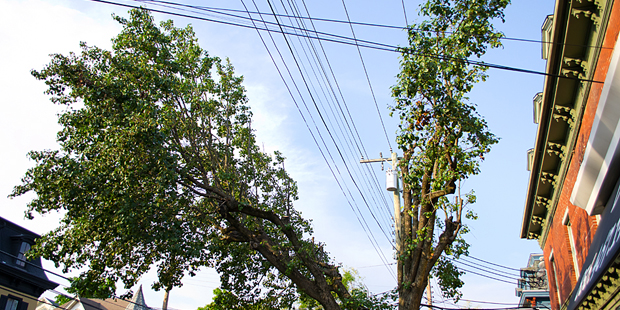Perhaps you’ve noticed as you’ve passed along Kings Highway that some of our trees appear to have fallen into the hands of an angry stylist. However, unlike the result of a bad trip to the salon, this ugly cut won’t look any better two weeks from now. These trees have been trimmed during a process called directional pruning, the most appropriate and acceptable practice to prune trees for electric utility line clearance. Information about this technique follows.
Sincerely,
Swedesboro Shade Tree Commission
——————————————————————————————————–
Vegetation Management Pruning Techniques
Pruning trees is one of the key activities that allows us to improve reliability – and it is a vital activity that directly affects public safety! Tree problems can easily cause power outages. Keeping trees properly pruned also minimizes the possibility of electrical contact, downed wires, and electrical fires, in addition to damaging or killing healthy trees.
Directional or Lateral Pruning
The term “lateral” is derived from the method of cutting a branch back to the next limb or lateral growing branch (see Figure 2), which mimics the way trees self-prune their branches in a forest. This technique reduces the number of fast-growing, multiple sprouts and directs the future growth of the tree away from the power lines. Lateral pruning involves removing only the branches that may endanger electrical wires. This selective pruning of specific branches retains more of the trees natural crown, a method proven to be healthier for the tree than arbitrary topping.
Basic Forms of Lateral Pruning
Wire location, limb size, or branch configuration may make it necessary to remove limbs back to the tree’s trunk. The tree species, its position in relation to our electric facilities, and line voltage are all factors in determining how much limb removal is required.
When trees are planted directly beneath power lines, branches must be cut back until a fork in the tree is reached. This is a natural junction that allows the arborist to direct new growth away and permits large trees to coexist with power lines.
Lateral Cuts
If the tree is next to power lines, then lateral cuts are made to direct the tree growth back and away from the power lines (see Figure 4). Branches above the power lines are directed up and back, while those below the power lines are directed down and back or removed to the trunk. Next season’s growth is then concentrated in the direction of the lateral cuts and away from the wires. Future pruning refines this procedure and improves the shape of the tree. These methods usually mean cutting fewer branches but achieving better electrical service reliability for our customers, and it is healthier for the trees.
Source: www.atlanticcityelectric.com

